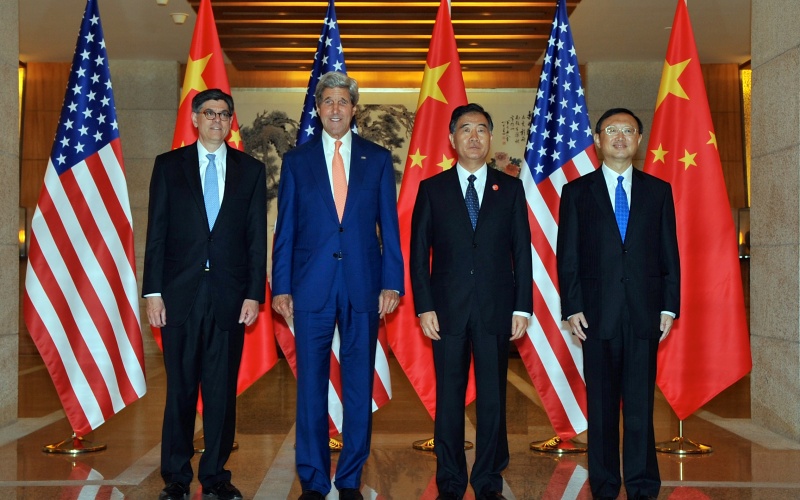The recent Strategic and Economic Dialogue highlighted the importance of steel production and the South China Sea in U.S.-China relations.

Between 6-7 June, the U.S. and China were engaged in the 8th Strategic and Economic Dialogue (S&ED). The meeting, established by President Obama and former Chinese president Hu Jintao in 2009, has notoriously failed to result in agreements. As a consequence, the forum is widely considered consultative, at best.
This year, the round was led by Secretary of State John Kerry and Lew on the U.S. side and Vice Premier Wang Yang and State Councilor Yang Jiechi, on the Chinese side. The agenda covered 9 areas and 120 topics ranging from disability rights, wildlife trafficking, currency and production oversupply, to space, nuclear nonproliferation and climate change. Two of these topics, in particular, caught the eyes of political and economic analysts.
Steel overcapacity
Cutting the excess capacity of steel, “which has a distorting and damaging effect on global markets” according to U.S. Treasury Secretary Jacob Lew was, by far, the most stringent economic issue on the table. China had promised earlier this year to address the much-needed reduction of the state-owned steel industry.
At the opening of the event, Chinese President Xi Jinping re-emphasized his commitment to address overcapacity, but without giving further details, while the Chinese finance minister said China needs time to allow market forces to reduce surplus production capacity.
China produces 50% of the world steel output, almost double the share it had in 2004. In 2015, it also consumed over 5% less than in 2013 when it was at its peak. As the market gradually became flooded with cheap Chinese steel, the U.S. imposed 210% anti-dumping and 241% anti-subsidy duties for the Chinese steelmakers.
World crude steel production and consumption in 2015
 Source: World Steel Association, World Steel in Figures – 2016
Source: World Steel Association, World Steel in Figures – 2016
Massive layoffs in the steel and coal industries have already caused strikes throughout the country, and over a million workers are expected to lose their jobs by the end of this year. There is obviously some willingness on behalf of the Chinese government to address the problem of state-owned enterprises (SOEs) which have low productivity and operate at a loss.
Source: World Steel Association, World Steel in Figures – 2016
However, the bad debt accumulated by the SOEs in question will become a serious problem for the banking system which is not equipped to cope. Steel and coal industry debts combined account for 1/3 of overall bank debt.
A wave of consolidations among the steel mills is underway, but it will by no means solve the problem. Rather, the problem will be shoved under the rug, allowing even the most uncompetitive enterprises to continue to exist.
If we look at the privatization initiatives in post-communist eastern Europe, this will come at a high price. The price will include social unrest, income polarization, migration and increase in regional disparities. The combination of all of these reasons was a factor in why governments were repeatedly overthrown during this period.
South China Sea disputes
The territorial disputes in the South China Sea between China and Brunei, Indonesia, Malaysia, Philippines, Taiwan and Vietnam were this year’s Pandora’s box. The issue also had the potential of jeopardizing the other items on the agenda.
However, U.S. Secretary of State John Kerry was eager to appease China, stating that the U.S. has not taken any position regarding China’s claim in the South China Sea. Kerry also stated his hope for a participative, diplomatic, thorough rule-of-law approach. The statement came only days after China’s rejection of U.N. jurisdiction over the matter. What Kerry had in mind remains cloaked in mystery.
Beyond the debate of who owns the mineral rights of the rich proven reserves of oil, the conflict has the potential to affect global business significantly. More than 50% of world maritime shipments pass through the straights of the South China Sea for a total of over $5.3 trillion.
This trade includes oil tankers sailing from the Middle East to South Korea, Japan, Taiwan and China. Ensuring freedom of navigation is paramount since rerouting ships would mean higher costs, higher lead times and ultimately a decrease in competitiveness for the smaller Asian countries.
The latter countries are looking hopefully at the ratification of the Trans-Pacific Partnership (TPP), which will translate into an increase of exports towards North and South American markets. The TPP eliminates over 18,000 tariffs between 12 Pacific Rim Countries: Singapore, Brunei, New Zealand, Chile, United States, Australia, Peru, Vietnam, Malaysia, Mexico, Canada and Japan. It covers 810 million people, 38% of world GDP and 26% of world trade.
International opinion seems to agree on the lack of efficiency of the U.S. – China Strategic and Economic Dialogue in general, and this 8th round in particular.
The main disappointment is centered around the lack of progress made in the territorial disputes and the inability of the U.S. to assume a leading role in mediating the conflict.
Similarly, Thomas Gibson, President and CEO of the American Iron and Steel Institute (AISI) commented on the unclear outcome of the round on the steel oversupply.
He stated that, while he appreciates the efforts made by the two governments, “(…) commitments will only be meaningful if they lead to real results that produce a significant net reduction in excess steel capacity in China”.
This skepticism has outlived the talks and no quick fix is on the horizon. All signs show that both the South China Sea dispute and the steel oversupply issue will be realities beyond 2016. As far as the actual forum itself is concerned, the possibility of a 9th round of S&ED — an Obama administration initiative — is unclear, especially with lacking tangible results.
sourche: http://globalriskinsights.com/2016/06/china/

Δεν υπάρχουν σχόλια:
Δημοσίευση σχολίου